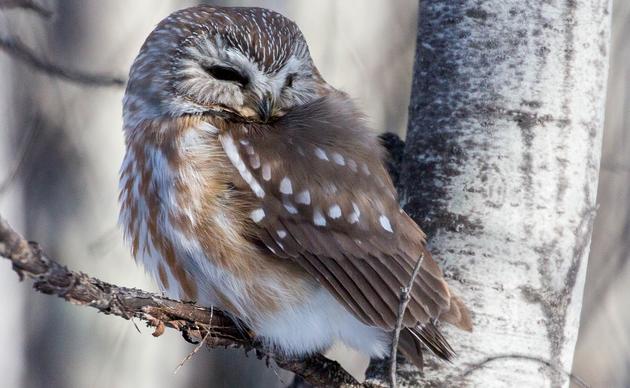(WASHINGTON – January 30, 2019) “Birds collide with buildings and die because of glass, which they don’t typically perceive as a barrier. A window that’s reflecting trees and sky looks like trees and sky, or they are attracted to something on the inside, and they fly into the glass at fatal speeds. The bright lights of buildings can also attract night migrating birds, also with dire consequences,” said John Rowden, Director of Community Conservation at National Audubon Society. “The Federal Birds-Safe Buildings Act is an evidence-based bill that would make new federal buildings safer for birds as well as more energy efficient, all at no extra cost to taxpayers. Audubon enthusiastically supports this legislation and thanks Congressman Quigley and Congressman Griffith for their commitment to protecting birds.
Today, Congressman Mike Quigley (D-IL) and Congressman Morgan Griffith (R-VA) introduced a bipartisan U.S. House bill with Lee Zeldin (R-NY) and Steve Cohen (D-TN). This legislation establishes guidelines for all future construction and alteration projects on federal buildings, where practicable. Senator Booker (D-NJ) introduced a Senate version in the last session of Congress.
“We applaud this bipartisan bill and its potential to address an immediate threat to birds – like the American Woodcock and Wood Thrush – which migrate through east coast cities up and down the Atlantic Flyway each spring and fall. Collisions with glass buildings and windows are a major source of mortality for these and other species each year,” said Ana Paula Tavares, executive director of Audubon New York.
Collisions with human-made structures are a leading cause of bird deaths in the United States. An estimated 300 million to 1 billion birds die each year from building collisions. Generally the more glass on a building, the greater the danger to birds in flight. Incorporating bird-friendly design can reduce collision deaths by up to 90 percent.
“Current guidelines for bird-friendly design are optional. When elements are incorporated from project inception, they do not increase cost. Coupled with sustainable design, the results can be stunningly beautiful, storm resilient, and financially efficient,” said Kathryn Heintz, executive director, New York City Audubon. “The Jacob K. Javits Convention Center and the soon-to-open Statue of Liberty Museum on Liberty Island in New York Harbor provide splendid examples in an ultra-urban setting.”
Some bird species of conservation concern are more likely than others to die from window collisions, including the Golden-winged Warbler, Painted Bunting, Canada Warbler, Wood Thrush, Kentucky Warbler, and Worm-eating Warbler. According to a 2009 study, window strikes are also the leading cause of urban mortality for Sharp-shinned Hawks, Cooper’s Hawks, Merlins, and Peregrine Falcons. This and more information is available in the New York City Audubon and American Bird Conservancy comprehensive Bird-Friendly Building Design report and guide.
A key guideline in the bird-safe legislation would reduce the amount of plain glass to a maximum of 10 percent of the first 40 feet of a building’s façade, and a maximum of 40 percent above the 40-foot threshold. Using patterned glass instead of plain glass allows birds to see glass surfaces and avoid collision. Smarter lighting practices that reduce light pollution and save energy are also included in the legislation’s guidelines. Many birds migrate at night and can be disoriented by lighting, and best practices include using automatic lights that turn off while not in use and shielded lights, which protect birds flying overhead.
The National Audubon Society works with state governments to guide the implementation of bird-safe building codes. For example, New York Governor Andrew Cuomo announced his state’s participation in the Lights Out Initiative, an effort spearheaded by Audubon New York to turn off unessential outdoor lighting during peak bird migration seasons. In the Twin Cities, Project BirdSafe is a joint effort between Audubon Minnesota and the Minnesota Department of Natural Resources to reduce the number of birds killed or injured by building collisions. Atlanta Audubon is one of many local chapters leading on both light reduction and making buildings safer for birds.
The National Audubon Society protects birds and the places they need, today and tomorrow, throughout the Americas using science, advocacy, education and on-the-ground conservation. Audubon’s state programs, nature centers, chapters and partners have an unparalleled wingspan that reaches millions of people each year to inform, inspire and unite diverse communities in conservation action. Since 1905, Audubon’s vision has been a world in which people and wildlife thrive. Audubon is a nonprofit conservation organization. Learn more at www.audubon.org and @audubonsociety.
About Audubon New York
Audubon New York, a state program of the National Audubon Society, protects birds and the places they need, today and tomorrow, throughout the Americas using science, advocacy, education and on-the-ground conservation. Audubon’s state programs, nature centers, chapters and partners have an unparalleled wingspan that reaches millions of people each year to inform, inspire and unite diverse communities in conservation action. Since 1905, Audubon’s vision has been a world in which people and wildlife thrive. Audubon is a nonprofit conservation organization. Learn more at www.ny.audubon.org.
###
Contact: Sharon Bruce, Communications Manager
sbruce@audubon.org
518-869-9731

By Audubon New York
Contribute to Our Conservation Success
You play an important role in our mission to protect birds & the habitats they need to survive.




